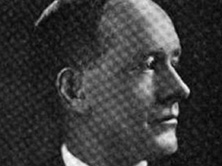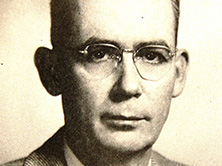 First North Carolina Chief Bridge Engineer William L. Craven (North Carolina Highway Bulletin, January 1922)
First North Carolina Chief Bridge Engineer William L. Craven (North Carolina Highway Bulletin, January 1922) State engineers found ways to design and build bridges quickly and efficiently to meet the demands of a large state highway system. The state’s first two chief bridge engineers, William L. Craven (1917-1944) and T.B. Gunter, Jr. (1945-1960), adopted standardized plans and written specifications that could be readily applied to the most common span lengths and roadway widths.
Standardization was not a new idea. It had been employed by railroad companies beginning in the mid-19th century and was in common usage by many highway departments across the country by the 1910s. Because standardized bridge plans used commonly available materials and well-tried bridge types and designs whose qualities and costs were known, they were generally more economical.
They were particularly well-suited to North Carolina because there were few large rivers needing specialized long-span or movable bridges. Some standardized bridge designs, for example plans adopted for reinforced concrete T-beam and slab bridges in 1919, served as prototypes for spans built across the state for more than 40 years.
 T.B. Gunter, Jr., North Carolina's second Chief Bridge Engineer, ca.1952 (from Capus Waynick, North Carolina Roads and their Builders) Craven had as much as any individual to do with shaping the standardized approach to bridge design and construction. He was born in Concord in 1878 and graduated from North Carolina Agricultural & Mechanical College (now North Carolina State University) in 1901 with a civil engineering degree. After working for several bridge-building companies, Craven joined the State Highway Commission in 1917 and soon recruited a dedicated force of young engineers to its bridge department (these included Gunter, his successor, who came to the Commission after receiving a civil engineering degree from the University of North Carolina in 1921.)
T.B. Gunter, Jr., North Carolina's second Chief Bridge Engineer, ca.1952 (from Capus Waynick, North Carolina Roads and their Builders) Craven had as much as any individual to do with shaping the standardized approach to bridge design and construction. He was born in Concord in 1878 and graduated from North Carolina Agricultural & Mechanical College (now North Carolina State University) in 1901 with a civil engineering degree. After working for several bridge-building companies, Craven joined the State Highway Commission in 1917 and soon recruited a dedicated force of young engineers to its bridge department (these included Gunter, his successor, who came to the Commission after receiving a civil engineering degree from the University of North Carolina in 1921.)
Their approach to bridge design was conservative, using mostly well-tried and economical bridge types that gave the state good value and allowed the benefits of improved bridges to be spread to all corners of the state. Between 1920 and 1929, the State Bridge Commission designed an average of about 200 new bridges each year that were 20-feet-long or longer and 800 culverts of less than a 20-foot span.